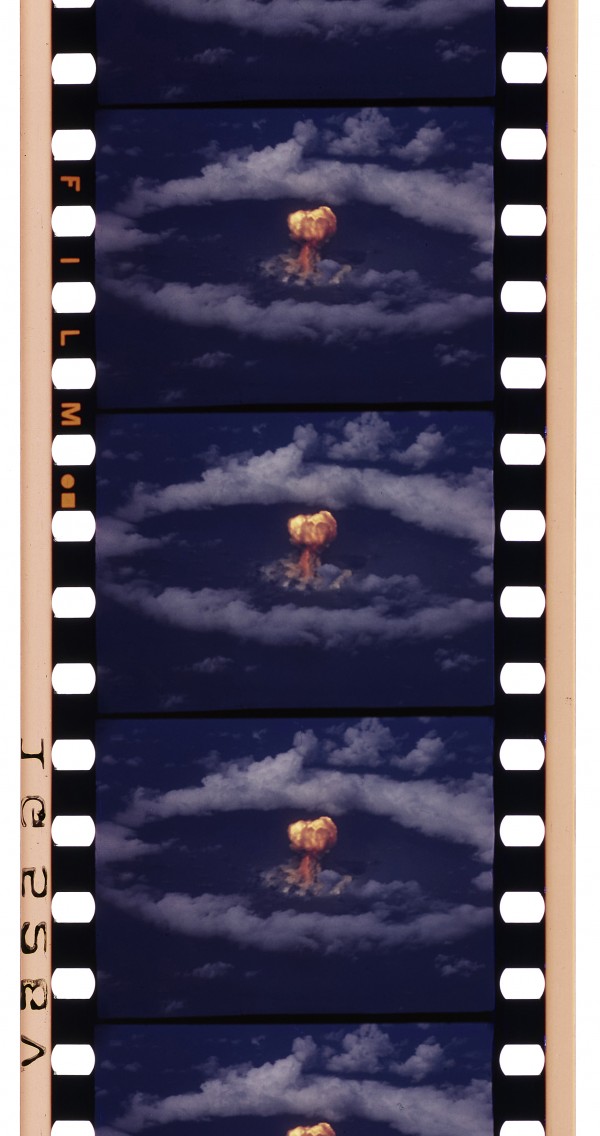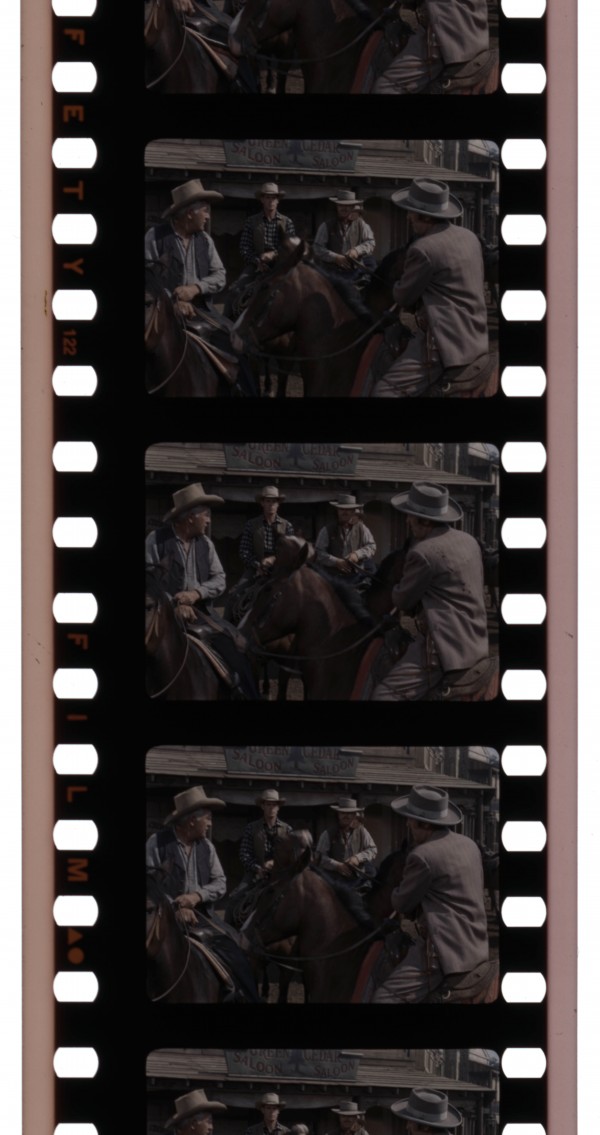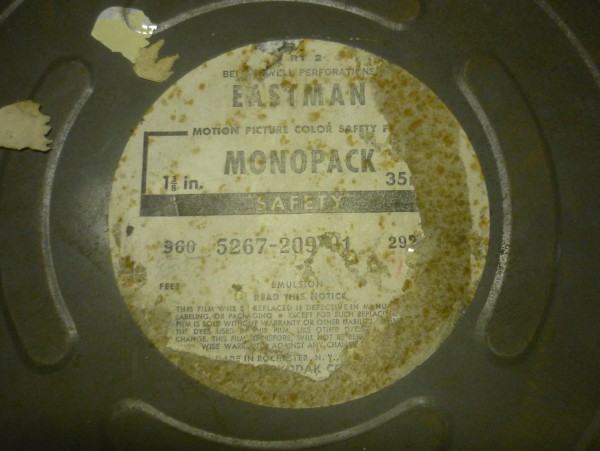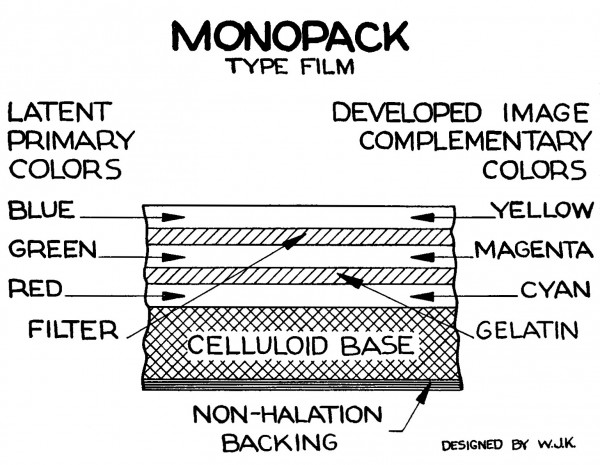A 35mm chromogenic color camera stock developed by Eastman Kodak and Technicolor that could be used in a normal camera without the need for the Technicolor beam-splitting system or YCM (yellow, cyan, magenta) separations. This modified Kodachrome reversal film was optimized for duplication via Technicolor dye-transfer printing.
Film Explorer

Project Crossroads, Bikini Island, 1 and 25 July 1946 (1946). Atomic bomb test at Bikini Atoll, Marshall Islands. In 1946, the United States military used Monopack film to record a series of bomb tests. In this case, there were no Technicolor release prints made. The military used Monopack for the convenience of a 35mm color film record that they could shoot with a regular camera.
342-USAF-34282, Reel 5, National Archives and Records Administration, College Park, MA, United States.

The Younger Brothers (1949). Monopack film was used on multiple studio productions and documentaries in the United States and the United Kingdom during the 1940s and early 1950s, primarily on films photographed mostly outdoors, like this western.
Turner Entertainment Collection, The Museum of Modern Art, New York, NY, United States.
Identification
1
Monopack film did not record the full spectrum accurately. The stock captured saturated colors with an overall blue bias. Contrast was intensified, making diffused sunshine bright white and notably affected the blue spectrum, rendering blue skies a vivid blue (Clarke, 1945).
None
All Monopack originals are mute.
Both Academy 20.96 mm x 15.24 mm (0.825 in x 0.600 in) and full aperture 24.89 mm x 18.67 mm (0.980 in x 0.735 in) frames were used for filming, depending on the camera.
Technicolor Monopack was a modified version of Kodachrome and has many of the same physical and visual characteristics including the signature black between the perforations. According to internal reports from 1941, compiled by Director of the Color Technology Division of Eastman Kodak Ralph M. Evans, there were four layers (from top to bottom): a low-contrast yellow layer, a magenta layer, an inter-layer to improve the exposure in the magenta layer and a green/cyan layer.
Standard Eastman Kodak edge code dating symbols were used, but in a non-standard placement. The text appears in orange against a black background, in the spaces between the perforations instead of along the edge of the film. The outside edges of the film are orange.
History
Technicolor Monopack was a developmental single-strip color film stock created by Eastman Kodak in conjunction with Technicolor. It was a modified version of the Kodachrome reversal process, which was originally developed for amateur use. Monopack was born in the pursuit to develop an all-in-one commercial color film stock that could be used in traditional B/W motion picture cameras, then printed by Technicolor to make dye-transfer prints. In a cooperative arrangement forged in 1934, engineers at both companies developed a 35mm version of Kodachrome, which had previously only been available in 8mm and 16mm, as well as slide film for photography (Anon., 1934). Technicolor had Leonard Troland’s 1921 monopack patent and Kodak had Leopold Mannes and Leopold Godowsky Jr.’s technical expertise). The agreement between the two companies included an exclusive licensing agreement for Technicolor to procure the product from Kodak. While they were much further along in developing a single-strip color stock with Godowsky and Mannes’ patents covering many of the details and did not believe Technicolor had made similar meaningful advances, Kodak pursued the deal to protect their own products from claims of patent infringement (Lovejoy, 1934).
The working relationship between the two companies was outlined in the May–June 1944 issue of the Motion Picture Herald:
“Technicolor Monopack [was] developed from the Eastman Kodachrome film. But many changes were introduced by Technicolor in the research which led to a film capable of recording three separate color impressions on one film strip. Technicolor, with its background of production experience, developed the process while Eastman collaborated on the perfection of dyes and emulsions for the new Technicolor Monopack.”
The single strip, full-color emulsion allowed camera operators to capture color, instead of using the traditional Technicolor three-strip method. From there, separations could be made to proceed with the Technicolor printing process. The film was processed at the Eastman Kodak Company in Rochester, NY and in Hollywood, CA. Monopack was also used in the United Kingdom, but had to be sent to Hollywood for processing.
Due to its experimental nature, Technicolor at first limited the use of Monopack to cinematography in difficult environments where camera size, mobility and speed were required beyond what could be accomplished using the bulky three-strip Technicolor camera (Kalmus, 1941). Early on, in addition to footage used in Dive Bomber (1941) and Captain of the Clouds (1942), Monopack film was also used in industrial films, animation, military training films and for special effects, where mobility and high speed was important. Technicolor’s Herbert T. Kalmus said in a 1942 address to Technicolor stakeholders that Monopack lacked film grain texture and uniformity, but that the “latitude, visibility, and tone rendition” was satisfactory (Hoch, 1942).
As late as 1943, the introduction of Technicolor Monopack was not coming along well. Production of the film stock was plagued with inconsistencies, with Kodak discarding whole batches and unable to fulfil orders in a timely manner. MGM expressed dissatisfaction with the quality of scenes shot on Monopack for Lassie Come Home (1943), but went forward with shooting anyway (Anon., 1943). However, there were many parties interested in trying out the new stock, including the United States government, for a “part cartoon, part live action … study in venereal disease”, the United States Navy and Marines, and the Army Signal Corps, which “want[ed] to do ten two-reel training films during the balance of the year, calling for 150,000 feet of monopack” (Anon., 1943).
By 1945, Monopack began to gain a tiny foothold in the industry. Twentieth Century-Fox used the stock to shoot all scenes for Thunderhead, Son of Flicka (1945) and the United States Army Air Corps had purchased 150,000 ft of the film (Anon., 1945). Charles G. Clarke, director of photography for Thunderhead, Son of Flicka, outlined his experiences with the film, saying, “much is yet to be learned about monopack, and no one at the present stage of development can presume to make any statements with final authority”. Initial reports indicated that the contrast range was similar to 16mm Kodachrome film but that “the exposure latitude has been widened with monopack and a certain amount of over- or underexposure may be controlled and brought into line through the latitude of the release print process”. Further contrast was introduced during the film development process. Exterior scenes with bright lighting could be controlled for, but interior scenes suffered and had to be shot with soft lighting to gain acceptable results (Clarke, 1945).
The greatest advantage in the use of Monopack was not the film stock itself, but rather the use of lighter weight cameras that could be more easily maneuvered. This allowed for easier shooting in difficult terrain in Africa on King Solomon’s Mines (1950), on a mountain for The White Tower (1950) and aerial photography for Dive Bomber and Captains of the Clouds. Another distinct advantage was an increase in sharpness and a decrease in color registration issues resulting in diffuse color prints shown to audiences from the traditional three-strip Technicolor method (Clarke, 1945).
The United States Army Air Corps and Marines purchased Monopack stock in 1945. The Army Air Corps used Monopack to photograph Operation Crossroads in July 1946 and shot 35 reels of Monopack for William Wyler’s Thunderbolt (1947).
Technicolor Monopack never became an industry standard and was supplanted with the introduction of the Eastman Color single-strip negative in 1950 (also sometimes referred to as “monopack”). Concurrently in 1950, the United States Department of Justice filed an anti-trust complaint against Eastman Kodak and Technicolor for unfair trade practices, putting an end to the partnership.
Selected Filmography
The first Hollywood production to use Monopack film for select aerial scenes.
The first Hollywood production to use Monopack film for select aerial scenes.
One of the last Monopack productions. Filmed on location in Australia.
One of the last Monopack productions. Filmed on location in Australia.
Filmed on location in Africa.
Filmed on location in Africa.
A series of military training films made for the Waller Flexible Gunnery Trainer.
A series of military training films made for the Waller Flexible Gunnery Trainer.
An unedited record in color of the United States Army Air Force’s nuclear bomb tests at Bikini Atoll, in the Marshall Islands.
An unedited record in color of the United States Army Air Force’s nuclear bomb tests at Bikini Atoll, in the Marshall Islands.
A Movietone News documentary sports film photographed using a mix of Monopack and three-strip Technicolor cameras.
A Movietone News documentary sports film photographed using a mix of Monopack and three-strip Technicolor cameras.
One of three “experimental” Monopack shorts photographed in Great Britain during the Second World War when there was a shortage of Technicolor cameras. The Monopack film had to be shipped to the United States for processing.
One of three “experimental” Monopack shorts photographed in Great Britain during the Second World War when there was a shortage of Technicolor cameras. The Monopack film had to be shipped to the United States for processing.
A wartime documentary filmed using a mix of 35mm Monopack and 16mm Kodachrome.
A wartime documentary filmed using a mix of 35mm Monopack and 16mm Kodachrome.
A western animal picture following a boy’s relationship with a young race horse. Many outdoor “animal pictures” were photographed using Monopack film, including multiple Lassie films.
A western animal picture following a boy’s relationship with a young race horse. Many outdoor “animal pictures” were photographed using Monopack film, including multiple Lassie films.
A western filmed primarily outdoors.
A western filmed primarily outdoors.
Technology
Technicolor Monopack was a 35mm reversal color stock, intended for use in commercial film production. Kodak modified the standard Kodachrome emulsion and processing formulas so that images photographed on Monopack would result in optimized Technicolor prints. In order to achieve this, the emulsion layers required several adjustments and exposure conditions in conjunction with precise chemical mixing and processing specifications. The magenta curve (exposure) was adjusted to more closely align with the yellow and cyan layers, and a fourth inter-layer was introduced between the cyan and magenta layers to improve the magenta shoulder characteristics. Changes in the cyan dye were made to decrease graininess. Increased emulsion speed lowered the spectral absorption in the yellow dye. In processing, modified developers and couplers improved grain and enhanced the shoulder characteristics of the color curve (Evans, 1941).
In the October 1945 issue of International Photographer, William Kenney wrote about the complex process:
“Monopack is developed as a negative. After development the three images formed are bleached out and the remaining silver halide is exposed and developed in “coupler” developers. The resultant images are positive and dyed with colors complimentary to the colors recorded by the emulsion layers. Where these dyed images over-lap or superimpose each other they produce, when viewed by transmitted light, different colors, depending on the proportions of color in the over-lapping images.”
References
Anon. (1934). “License Agreement”. Technicolor Motion Picture Corporation and Eastman Kodak Company. June 12, 1934. United States v. Technicolor, Inc., Technicolor Motion Picture Corp., and Eastman Kodak Co., Civil Action No. 7507-WM (S.D. CA 1947). Department of Justice (DOJ) File 60-42-12, Serial 83 Enclosures, Subfile: T25 - T47 Inclusive, General Records of the Department of Justice, Record Group (RG) 60, National Archives at College Park, College Park, MD, United States.
Anon. (1943). “Notes for Use in Conference with Dr. Mees, New York City, Friday, April 16, 1943”. United States v. Technicolor, Inc., Technicolor Motion Picture Corp., and Eastman Kodak Co., Civil Action No. 7507-WM (S.D. CA 1947). Department of Justice (DOJ) File 60-42-12, Serial 83 Enclosures, Subfile: T25 - T47 Inclusive, General Records of the Department of Justice, Record Group (RG) 60, National Archives at College Park, College Park, MD, United States.
Anon. (1944). “Kalmus Reticent But Enthusiastic Over Monopack”. Motion Picture Herald, 155:8 (May 20): p. 41.
Anon. (1945). “Monopack (Film)”. Central Decimal Correspondence Files 1919 – 1950, Records of U.S. Air Force Commands, Activities, and Organizations 1900 – 2003, Record Group 342; National Archives at College Park, College Park, MD, United States.
Anon. (1952). “India Called Active Field For Technicolor”. Technicolor News and Views, 14:4 (December): p. 7.
Berns, Samuel D. (1944). “Color in 1944”. The 1945 Film Daily Yearbook of Motion Pictures: p. 69.
Cave, George A. (1941). Correspondence with John A. Stoeller, November 24, 1941. United States v. Technicolor, Inc., Technicolor Motion Picture Corp., and Eastman Kodak Co., Civil Action No. 7507-WM (S.D. CA 1947). Department of Justice (DOJ) File 60-42-12, Serial 83 Enclosures, Subfile: T25 - T47 Inclusive, General Records of the Department of Justice, Record Group (RG) 60, National Archives at College Park, College Park, MD, United States.
Clarke, Charles G. (1945). “Practical Utilization of Monopack Film”. Journal of Society of Motion Picture Engineers, 45:5 (November): pp. 327–332.
Department of Justice (1947). United States v. Technicolor, Inc., Technicolor Motion Picture Corp., and Eastman Kodak Co., Civil Action No. 7507-WM (S.D. CA 1947). Department of Justice (DOJ) File 60-42-12, Serial 83 Enclosures, Subfile: T25 - T47 Inclusive, General Records of the Department of Justice, Record Group (RG) 60, National Archives at College Park, College Park, MD, United States.
Evans, Ralph M. (1941). [Revised Monopack Process], Eastman Kodak Company, September 26, 1941. John Andreas Collection, George Eastman Museum, Rochester, NY, United States.
Farrar, Vincent (1950). “Tough Assignment”. American Cinematographer, 31:2 (February): p. 48.
Friedman, J. S. (1944). “Monopack Processes”. Journal of the Society of Motion Picture Engineers, 42:5 (May): pp. 271–278.
Hoch, Winton (1942). “Technicolor Cinematography”. Journal of Society of Motion Picture Engineers, 39:7 (July): pp. 96–108.
Kalmus, Herbert (1941). Correspondence with E. J. Mannix, January 7, 1941. United States v. Technicolor, Inc., Technicolor Motion Picture Corp., and Eastman Kodak Co., Civil Action No. 7507-WM (S.D. CA 1947). Department of Justice (DOJ) File 60-42-12, Serial 83 Enclosures, Subfile: T25 - T47 Inclusive, General Records of the Department of Justice, Record Group (RG) 60, National Archives at College Park, College Park, MD, United States.
Kenney, William (1945). International Photographer, October 1945: p. 7.
Lovejoy, Frank W. (1934). Correspondence with Edward Peck Curtis, March 29, 1934. United States v. Technicolor, Inc., Technicolor Motion Picture Corp., and Eastman Kodak Co., Civil Action No. 7507-WM (S.D. CA 1947). Department of Justice (DOJ) File 60-42-12, Serial 83 Enclosures, Subfile: T25 - T47 Inclusive, General Records of the Department of Justice, Record Group (RG) 60, National Archives at College Park, College Park, MD, United States.
Patents
Troland, Leonard T. 1931. Color Photography. U.S. Patent No. 1,808,584. Washington, DC: U.S. Patent and Trademark Office.
Mannes, Leopold D. & Leopold Godowsky, Jr. 1935. Color Photography, US Patent 1,997,493, filed January 24, 1922, patented April 9, 1935.
Mannes, Leopold D. & Leopold Godowsky, Jr. 1938. Color Photography, US Patent 2,113,329, filed February 27, 1935, patented April 5, 1935.
Preceded by
Followed by
Compare
Related entries
Authors
Audrey Amidon is a Motion Picture Preservation Specialist, and Criss Austin is the Supervisory Motion Picture Preservation Specialist, at the National Archives and Records Administration (NARA). During their combined four decades of experience they have preserved, restored and digitized millions of feet of government film records. They have organized conferences and presented on government film and film preservation, given lectures and provided preservation and technical guidance for federal agencies, cultural institutions within the United States and around the world and for the general public.
Criss Austin is the supervisor of the Motion Picture Preservation Lab at the National Archives and Records Administration (NARA). Over the course of her career she has overseen preservation and digital restoration projects including Nine From Little Rock, A Year Toward Tomorrow, With the Marines at Tarawa, The Negro Soldier, Let There Be Light, and The March. She conducted forensic scanning of the Iwo Jima flag raising footage to assist in determining the identity of the Marines, and completed digital restoration of Eva Braun’s home movies. She has moved the Lab from a purely photochemical operation to a state-of-the-art digitization facility while maintaining traditional film to film preservation capabilities. She is an active participant with the Association of Moving Image Archivists, The Federal Agencies Digitization Guidelines Initiative, and is a participant on the International Federation of Film Archives Technical Committee. She holds a degree from Oberlin College in History, from The Nottingham Trent University in Cinema Studies, and received certification from The L. Jeffrey Selznick School of Film Preservation in 2002.
Our gratitude goes to Sophia Lorent of the George Eastman Museum, for digitizing and sharing files from the John Andreas Collection; James Layton for sharing his copies of the Department of Justice files held at NARA and Lindsay Oakley and Jennifer Hermann of NARA’s Heritage Science and Research Testing Branch for testing a Monopack sample to confirm the composition of the film base. Credit goes to Jennifer Seitz for photographing NARA’s Operation Crossroads reels and other records for Film Atlas.
Amidon, Audrey & Criss Austin (2024). “Technicolor Monopack”. In James Layton (ed.), Film Atlas. www.filmatlas.com. Brussels: International Federation of Film Archives / Rochester, NY: George Eastman Museum.




